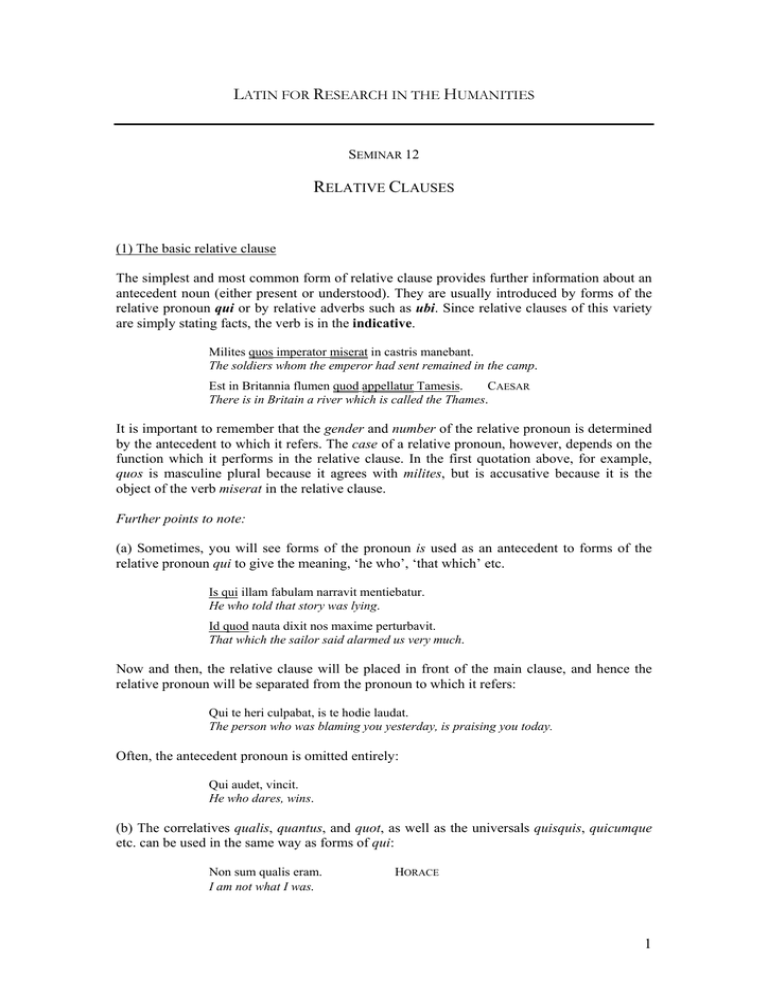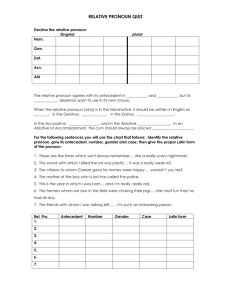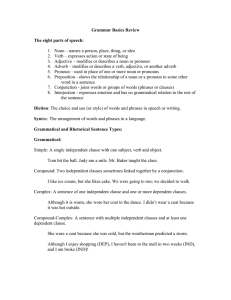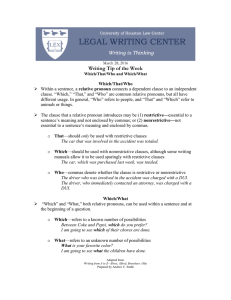L R H
advertisement

LATIN FOR RESEARCH IN THE HUMANITIES SEMINAR 12 RELATIVE CLAUSES (1) The basic relative clause The simplest and most common form of relative clause provides further information about an antecedent noun (either present or understood). They are usually introduced by forms of the relative pronoun qui or by relative adverbs such as ubi. Since relative clauses of this variety are simply stating facts, the verb is in the indicative. Milites quos imperator miserat in castris manebant. The soldiers whom the emperor had sent remained in the camp. Est in Britannia flumen quod appellatur Tamesis. CAESAR There is in Britain a river which is called the Thames. It is important to remember that the gender and number of the relative pronoun is determined by the antecedent to which it refers. The case of a relative pronoun, however, depends on the function which it performs in the relative clause. In the first quotation above, for example, quos is masculine plural because it agrees with milites, but is accusative because it is the object of the verb miserat in the relative clause. Further points to note: (a) Sometimes, you will see forms of the pronoun is used as an antecedent to forms of the relative pronoun qui to give the meaning, ‘he who’, ‘that which’ etc. Is qui illam fabulam narravit mentiebatur. He who told that story was lying. Id quod nauta dixit nos maxime perturbavit. That which the sailor said alarmed us very much. Now and then, the relative clause will be placed in front of the main clause, and hence the relative pronoun will be separated from the pronoun to which it refers: Qui te heri culpabat, is te hodie laudat. The person who was blaming you yesterday, is praising you today. Often, the antecedent pronoun is omitted entirely: Qui audet, vincit. He who dares, wins. (b) The correlatives qualis, quantus, and quot, as well as the universals quisquis, quicumque etc. can be used in the same way as forms of qui: Non sum qualis eram. I am not what I was. HORACE 1 (2) Relatives introducing consecutive, final and causal clauses Relative pronouns can also be used to introduce consecutive, final and causal clauses: we have looked briefly at examples of some of these in previous seminars. In clauses of this variety, the subordinate clause contains a subjunctive. (a) Consecutive clauses The relative pronoun qui can be used to express a characteristic of the antecedent, and effectively means ‘of such a kind that’. A relative pronoun can introduce a consecutive clause in five ways: • After a demonstrative: Non sum is qui his rebus delecter. CICERO I am not the sort of person who delights in these things. • After indefinite and interrogative pronouns, as well as nemo, nihil, nullus, solus, and usus: CICERO Quis est cui non possit malum evenire? Who is there to whom evil cannot happen? • After est or sunt used in an indefinite manner: Sunt qui duos tantum in sacro monte creatos tribunos esse dicant. LIVY There are some who say that only two tribunes were elected on the sacred mount. • After comparatives with quam: Maiora deliquerant quam quibus ignosci posset. LIVY They had committed greater offences than could be pardoned. • After dignus or indignus: Dignus est qui imperet. He is worthy to govern. CICERO (b) Final clauses The relative pronoun can introduce a final (purpose) clause to indicate the end which something is intended to serve. The relative pronoun refers to – and thus agrees in gender and number with – the thing which is intended to serve the purpose. Clusini legatos Romam, qui auxilium a senato peterent, misere. The Clusini sent ambassadors to Rome to seek aid from the Senate. LIVY Quo can be used with a comparative to introduce a final clause: Castella communit quo facilius eos prohibere possit. CAESAR He strengthened the forts in order to keep them off more easily. (c) Causal clauses We will have occasion to return to causal clauses later, but it is sufficient to note for the present that qui can introduce a clause indicating the reason for which something is done. Miseret tui me qui hunc facias inimicum tibi. I pity you for making this man your enemy. TERENCE 2 Here, the subjunctive is used to indicate that the speaker does not happen to agree with the people he is addressing. So, in the case of this example, the speaker does not think that it was wise to make an enemy of ‘this man’. We will discuss uses of the indicative in causal clauses later. Exercises (1) Ubi est liber quem heri legebam? (2) Puella quae adstabat senem salutavit. (3) Captivi quos rex e carcere liberaverat maximas gratias ei egerunt. (4) Omnes cives imperatori, qui urbi iam appropinquabat, obviam ierunt. (5) Id quod dicis falsum est. (6) Nihil est quod tam deceat quam constantia. (Cicero) (7) Navem conduxi, quo celerius ad Italiam revenirem. ADDITIONAL FUN: THE FOURTH AND FIFTH DECLENSIONS, AND SUPINES 4th declension 5th declension Irregular manus, f. ‘hand’; genu, n., ‘knee’ dies, m., ‘day’ domus, f., ‘house’ Sing. Nom / Voc. Acc. Gen. Dat. Abl. manus manum manus manui manu genu genu genus genu genu dies diem diei diei die domus domum domus domui domo manus manus manuum manibus manibus genua genua genuum genibus genibus dies dies dierum diebus diebus domus domus/domos domuum/domorum domibus domibus Plural Nom / Voc. Acc. Gen. Dat. Abl. Supines The supine is used in the following ways: (1) In the accusative (portatum, doctum etc.), the supine can be used with verbs involving movement to indicate purpose: Cives dormitum abierunt The citizens went away to sleep. The accusative of the supine is also used with iri (present passive infinitive of eo) to form the future passive infinitive: Nuntius dicit villam deletum iri. 3 The messenger says that the villa will be destroyed. (2) In the ablative, the supine is used with certain adjectives: Monstrum terribile visu erat. The monster was terrible to see. A reminder of how the supine is formed: Infinitive Sup. acc. Sup. abl. 1st conj. 2nd conj. 3rd conj. 4th conj. portare portatum portatu docere doctum doctu trahere tractum tractu audire auditum auditu 4





